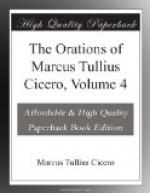“Quemnam te esse dicam, qui tarda in senectute” ...
And so on; for except when the flute-player is at hand to accompany them, those verses are very like prose. But the iambics of the common poets are, on account of their likeness to ordinary conversation, very often in such a very low style, that sometimes it is hardly possible to discover any metre, or even rhythm in them. And it may easily be understood that there is more difficulty in discovering the rhythm in an oration than in verses.
Altogether there are two things which season oratory—the sweetness of the language, and the sweetness of the rhythm. In the language is the material, and in the rhythm the polish. But, as in other things, the older inventions are the children of necessity rather than of pleasure; so also has it happened in this, that oratory was for many ages naked and unpolished, aiming only at expressing the meaning conceived in the mind of the speaker, before any system of rhythm for the sake of tickling the ears was invented.
LVI. Therefore Herodotus also, and his age, and the age preceding him, had no idea of rhythm, except at times by chance, as it seems. And the very ancient writers have left us no rules at all about rhythm, though they have given us many precepts about oratory. For that which is the more easy and the more necessary will always be the first thing known. Therefore, words used in a metaphorical sense, or inverted, or combined, were easily invented because they were derived from ordinary use, and from daily conversation. But rhythm was not drawn from a man’s own house, nor had it any connexion of relationship to oratory. And therefore it was later in being noticed and observed, bringing as it did the last touch and lineaments to oratory. But if there is one style of oratory narrow and concise, and another more vague and diffuse, that must clearly be owing, not to the nature of letters, but to the difference between long and short paragraphs; because an oration made up and compounded of these two kinds is sometimes steady, sometimes fluent, and so each character must be kept up by corresponding rhythm. For that circuitous way of speaking, which we have often mentioned already, goes on more impetuously, and hurries along, until it can arrive at its end, and come to a stop. It is quite plain, therefore, that oratory ought to be confined to rhythm, and kept clear of metre.
But the next question is, whether this rhythm is poetical, or whether it is of some other kind. There is, then, no rhythm whatever that is not poetical; because the different kinds of rhythm are clearly defined. For all rhythm is one of three kinds. For the foot which is employed in rhythm is divided into three classes; so that it is necessary that one part of the foot must be either equal to the other part, or as large again, or half as large again. Accordingly, the dactyl is of the first class, the paeon of the last, the iambic of the second. And how is it possible to avoid such feet in an oration? And then when they are arranged with due consideration rhythm is unavoidably produced.




